Visiting Budapest
Budapest with more than 1000-years of history has a lot to offer. From the middle of the nineteenth century Budapest underwent an unprecedented surge of building and expansion. In contrast with other European capital cities, whose transformation into a modern metropolis was the continuation of a long period of historical growth, Budapest attained world status and became largely what we know today over a period of only 40 to 50 years. This was not entirely due to the economic growth of the time but also to disasters like the great floods of 1838 in which thousands of buildings in Pest were ruined and a new, modern town grew up in their place.
The Parliament
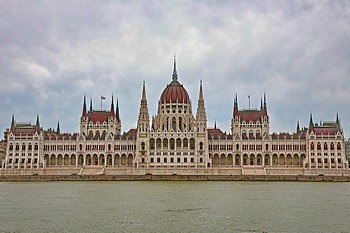 Town planners and builders of the late nineteenth century were certainly fond of grandeur and adornment – witness, for example, one of Europe’s most splendid parliament buildings on the left bank of the Danube. The building itself is a magnificent example of the art of the period – with its Gothic towers, intricate stonework and 90 statues on the outside, and its baroque grand staircase, frescoes, mosaic windows, Gobelin tapestry and paintings inside.
Town planners and builders of the late nineteenth century were certainly fond of grandeur and adornment – witness, for example, one of Europe’s most splendid parliament buildings on the left bank of the Danube. The building itself is a magnificent example of the art of the period – with its Gothic towers, intricate stonework and 90 statues on the outside, and its baroque grand staircase, frescoes, mosaic windows, Gobelin tapestry and paintings inside.
The cooling system for the Parliament building was unique at the end of the 19th century. Air ventilation tunnels were routed to the two fountains that were situated on the square in front of the building, and the fresh air blown back into the chambers was pleasantly cooled by water. When this system was later superseded, much of the tunnel work was bricked up although some of the original air passages are still in use today. In times of great heat, circulating air can be cooled by huge quantities of ice.
On the Trail of World Heritage – by Tram 2
Tram 2 is an excellent means for sightseeing because from its windows the entire World Heritage section of the Danube panorama of both Buda and Pest can be seen, among others the Hungarian Academy of Sciences, the Chain Bridge (Lánchíd) and the Parliament.
The Continent’s First Underground Railway
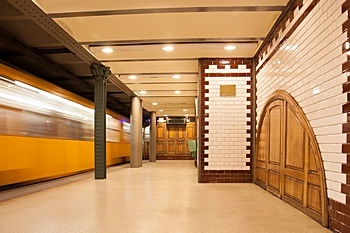 When Budapest’s first underground railway opened for service in 1896 it was the first of its kind on the Continent and only the second after London. It conveyed passengers just below street level from the City Centre to the City Park in around ten minutes. The 6-meter wide tunnel is supported by riveted iron pillars, the restored stations with their wooden ticket kiosks and ceramic tiled walls faithfully recall the atmosphere of the late nineteenth century.
When Budapest’s first underground railway opened for service in 1896 it was the first of its kind on the Continent and only the second after London. It conveyed passengers just below street level from the City Centre to the City Park in around ten minutes. The 6-meter wide tunnel is supported by riveted iron pillars, the restored stations with their wooden ticket kiosks and ceramic tiled walls faithfully recall the atmosphere of the late nineteenth century.
The Telegraph selected Budapest’s Metro 1 (the “Little Underground”) among the world’s best metros and underground lines in 2013.
The route of the original Little Underground follows that of Budapest’s most elegant Avenue. Andrássy út represents the pinnacle of Budapest’s late nineteenth century city planning. Its Eclectic Neo-Renaissance palaces and houses were built by the most distinguished architects of the time. Aristocrats, bankers, landowners and noble families moved in.
The Avenue is also home of many of Pest’s theatres including the imposing Opera House with its columns, statues and terraces, as well as the Operetta Theatre and numerous others on neighbouring streets. The area of Oktogon, an octagon shaped square, has become one of the capital’s favourite pleasure grounds in a short time, filled with cafés, international restaurants, club restaurants, music and jazz clubs.
Heroes’ Square
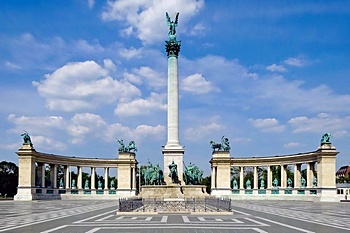 Andrássy út terminates opposite one of the best known and most visited groups of statues in Hungary, the Millennium Monument at Heroes’ Square (Hősök tere). The monument in the middle of the square was erected to commemorate the 1000-year-old history of the Hungarian conquest of the Carpathian Basin and the foundation of the Hungarian state. The centrepiece of the monument is a 36-meter Corinthian column holding a 5-meter statue of the Archangel Gabriel. In his right hand he holds the holy Hungarian crown, and in his left hand the double Apostolic cross – according to the legend just as he appeared in the dream of Hungary’s first king, St. Stephen I.
Andrássy út terminates opposite one of the best known and most visited groups of statues in Hungary, the Millennium Monument at Heroes’ Square (Hősök tere). The monument in the middle of the square was erected to commemorate the 1000-year-old history of the Hungarian conquest of the Carpathian Basin and the foundation of the Hungarian state. The centrepiece of the monument is a 36-meter Corinthian column holding a 5-meter statue of the Archangel Gabriel. In his right hand he holds the holy Hungarian crown, and in his left hand the double Apostolic cross – according to the legend just as he appeared in the dream of Hungary’s first king, St. Stephen I.
Around the base of the column equestrian statues of the seven chieftains of the conquering Hungarian tribes can be seen. Within the arched colonnades to the sides bronze figures represent the most illustrious rulers of the Hungarian History. At the foot of each statue a small relief depicts the most important moment of the life of the personality.
Largest Collection of Fine and Contemporary Arts
Heroes’ Square is surrounded by two important neo-classical buildings, the Kunsthalle (Műcsarnok) and the Museum of Fine Arts (Szépművészeti Múzeum). The Kunsthalle (Műcsarnok) is Hungary’s largest fine arts exhibition place and displays the works of contemporary Hungarian and international artists and designers. One of the museum’s missions is to portray the latest trends in visual arts by exposing young talents, beside well-established artists.
The Museum of Fine Arts (Szépművészeti Múzeum) is closed for renovations, its reopening is planned for March 2018.
The Castle District
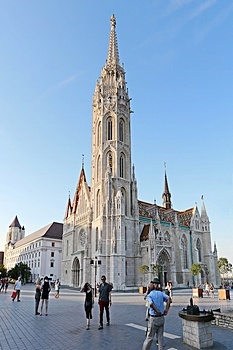 When locals say Buda Castle (Budai Vár) they are usually referring not just to the Royal Palace (Királyi Palota) but to the medieval town built on Castle Hill with its charming squares, narrow twisting streets and fantastic views over the city. It is worth going there for a walk, looking into the courtyards and visiting one of the most beautiful Gothic churches in all Hungary, the Church of Our Lady – more commonly known as the Matthias Church (Mátyás-templom). The over 700 year-old church was the scene of several coronations, including that of Charles IV in 1916, the last Habsburg king. In 1867, Matthias Church was the scene of a big coronation ceremony when Franz Joseph and his wife Elizabeth (“Sissy”) were crowned. Due to its excellent acoustics, it is a favourite venue for organ and chorus recitals and orchestral concerts.
When locals say Buda Castle (Budai Vár) they are usually referring not just to the Royal Palace (Királyi Palota) but to the medieval town built on Castle Hill with its charming squares, narrow twisting streets and fantastic views over the city. It is worth going there for a walk, looking into the courtyards and visiting one of the most beautiful Gothic churches in all Hungary, the Church of Our Lady – more commonly known as the Matthias Church (Mátyás-templom). The over 700 year-old church was the scene of several coronations, including that of Charles IV in 1916, the last Habsburg king. In 1867, Matthias Church was the scene of a big coronation ceremony when Franz Joseph and his wife Elizabeth (“Sissy”) were crowned. Due to its excellent acoustics, it is a favourite venue for organ and chorus recitals and orchestral concerts.
The castle is at the top of a hill as it is in all the best fairy tales. Known as the Royal Palace of Buda, it is visible from virtually every point of the city. The first castle was built in the thirteenth century after the Mongolian invasion and was a thick-walled fortress intended to withstand enemy attacks. In the fourteenth century it was enlarged in Gothic style and then at the time of one of Hungary’s greatest monarchs, King Matthias, it was remodelled into a Renaissance palace famed far and wide. The Turks took Buda without a battle in 1541 and for a while the medieval buildings remained structurally intact. Today part of the fortifications from this period can still be seen.
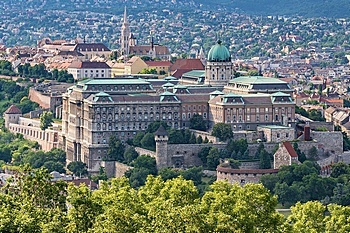 After 150 years of Turkish rule, ruined buildings were cleared away and in 1714 the building of a Baroque palace was raised up. It was further extended in the nineteenth century into the form with which we are familiar today. The Royal Palace was completely burned out during World War II, losing its valuable furniture and art treasures. The Hungarian National Gallery, the Budapest History Museum, the Museum of Contemporary Art and the main library of Hungary are housed in separate wings of the complex.
After 150 years of Turkish rule, ruined buildings were cleared away and in 1714 the building of a Baroque palace was raised up. It was further extended in the nineteenth century into the form with which we are familiar today. The Royal Palace was completely burned out during World War II, losing its valuable furniture and art treasures. The Hungarian National Gallery, the Budapest History Museum, the Museum of Contemporary Art and the main library of Hungary are housed in separate wings of the complex.
Gellért Hill and the Citadel
Gellért hill was named after St. Gellért (Gerald) who came to Hungary as a missionary bishop upon the invitation of King St. Stephen I. around 1000 A.D. His task was helping the Hungarians to convert to Christianity. Some pagan leaders who did not want to convert, captured the bishop and rolled him down from the hill in a barrel. The St. Gellért monument and fountain representing his martyrdom can be found on the North-eastern slope of the hill facing the Elisabeth bridge (Erzsébet-híd).
Budapest’s Statue of Liberty (Szabadság-szobor), the statue of a woman holding a palm branch over her head is visible from almost any point of Budapest.
The Capital with the World’s Largest Number of Thermal Springs
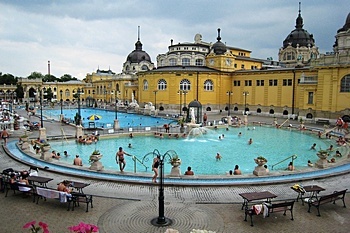 Budapest first gained the title of City of Spas in 1934 and since then it still holds it, because the city has more thermal and medicinal water springs than any other capital city in the world. It is a unique fact that the 118 natural or specially drilled springs – with a temperature ranging from 21 to 78°C – deliver 70 million litres per day. The particular mineral content of the waters marks them as being efficacious in the treatment of locomotor, circulatory and gynaecological disorders.
Budapest first gained the title of City of Spas in 1934 and since then it still holds it, because the city has more thermal and medicinal water springs than any other capital city in the world. It is a unique fact that the 118 natural or specially drilled springs – with a temperature ranging from 21 to 78°C – deliver 70 million litres per day. The particular mineral content of the waters marks them as being efficacious in the treatment of locomotor, circulatory and gynaecological disorders.
Walking along the Danube embankment on Buda side you come across the famous thermal baths one after the other. Visit the springs at Gellért tér just in front of Hotel Gellért.
Today, there are 15 public thermal baths in Budapest, not counting the private thermal spas established in some luxury hotels. There are also working thermal baths remaining from the Turkish period, for example Király and Rudas baths. Rudas is the oldest and most elaborately decorated bath, including a fine octagonal main pool.
